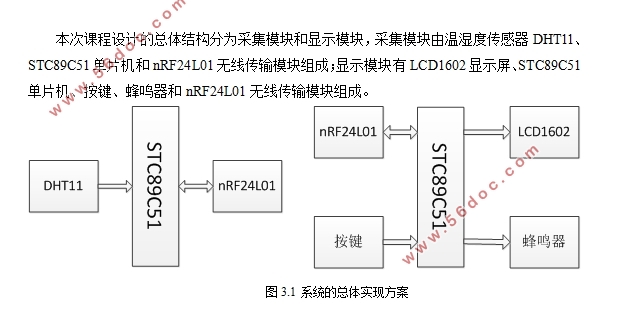基于无线通信的仓库环境监测系统设计
来源:56doc.com 资料编号:5D26864 资料等级:★★★★★ %E8%B5%84%E6%96%99%E7%BC%96%E5%8F%B7%EF%BC%9A5D26864
资料以网页介绍的为准,下载后不会有水印.资料仅供学习参考之用. 密 保 惠 帮助
资料介绍
基于无线通信的仓库环境监测系统设计(论文11000字)
摘要:温湿度是日常生产生活中的重要指标,是很多场景下的基本参数。本次设计中谈及的是仓库中的温湿度监测,温湿度是仓库的重要指标,所以对温湿度的检测就十分有必要。本次设计主要是运用无线通信的方式解决仓库的温湿度监测问题。将温湿度监测分为采集模块和显示模块,采集模块收集温湿度数据,并将其发送至显示模块,显示模块接收采集模块传输的温湿度信息,并将温湿度信息显示在液晶屏上,进行实时监测,超过设定温湿度范围时进行蜂鸣器报警。本次设计用到STC89C51单片机以及nRF24L01芯片,采用LCD1602显示屏。
关键词:无线通信技术,温湿度,数据传输
The Design of Granary Environment Monitor System
Based on the Wireless Data Transmission
Abstract:Temperature and humidity are important indicators of daily life,and they are the basic parameters of many scenes.The design is about monitoring the temperature and humidity of the warehouse, temperature and humidity is an important indicator of the warehouse, so the detection of temperature and humidity is very necessary. This design mainly uses the wireless communication method to solve the problem of monitoring warehouse environment.The temperature and humidity monitoring is consisted of two parts,sending module and receiving module. The sending module collects temperature and humidity information and send these information to receiving module.The receiving module receives these temperature and humidity information through wireless transmission module and displays the information of temperature and humidity on the LCD screen.The design uses the STC89C51 micro-controller and nRF24L01 chip ,as well as LCD1602 screen.
Key words: wireless data transmission technology, temperature and humidity , data transmission

目 录
1绪论 3
1.1课题的背景 3
1.2仓库环境监测的发展现状 3
1.3研究目的 4
2系统总体方案设计 4
2.1无线传输的方案选择 4
2.2LCD显示屏的方案选择 5
2.3传感器选择 5
2.4单片机主芯片选择方案 5
3硬件电路系统设计 6
3.1 STC89C51单片机芯片 6
3.2发送与接收的无线通信模块——nRF24L01 7
3.3稳压电路 10
3.4温度传感器DHT11 10
3.5 LCD显示屏1602 12
3.6 其他相关电路 13
4软件设计 14
4.1总体实现方案 15
4.2温湿度采集程序 17
4.3 nRF24L01发送和接收程序 18
4.4 LCD显示程序 19
4.5 温湿度上下限设置和报警程序 20
5系统测试 21
5.1软件部分测试 21
5.1.1 软件开发环境介绍 21
5.1.2 程序调试 24
5.2硬件部分测试 25
6总结 27
参考文献: 27
致谢 28
|



